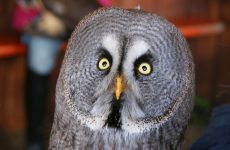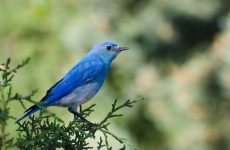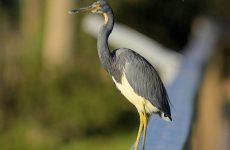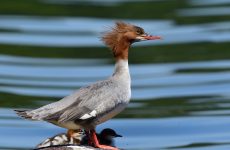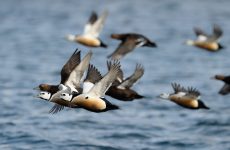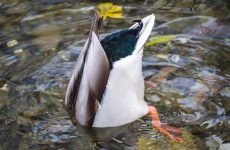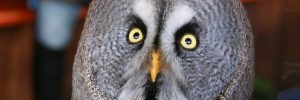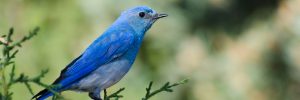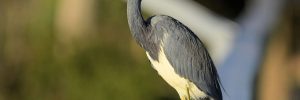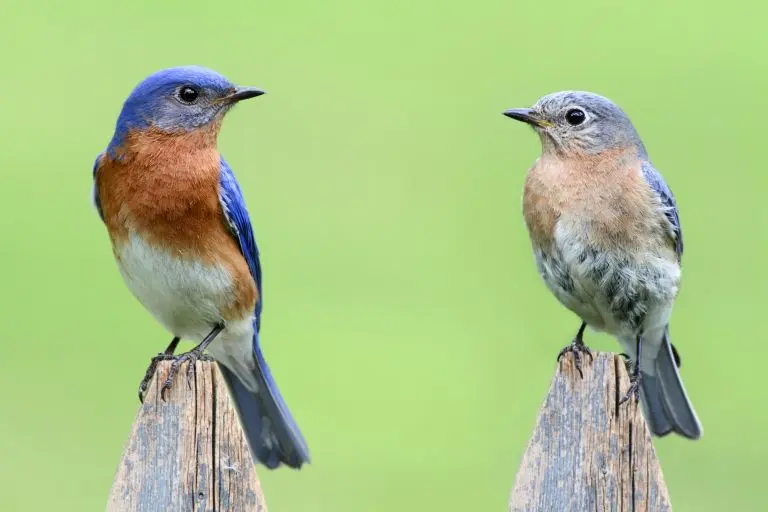
Surprisingly there are lots of birds with orange chests that you may see out in the woods, fields, or in your backyard.
I have rounded up 25 types of birds with orange chests in North America to help you identify those feathered friends.
Find out which state they live or visit and what habitats you are likely to see them in to help narrow down which birds with orange chests they may be.
So don’t delay check out all these orange-chested birds that you can spot.
1. Baltimore Oriole
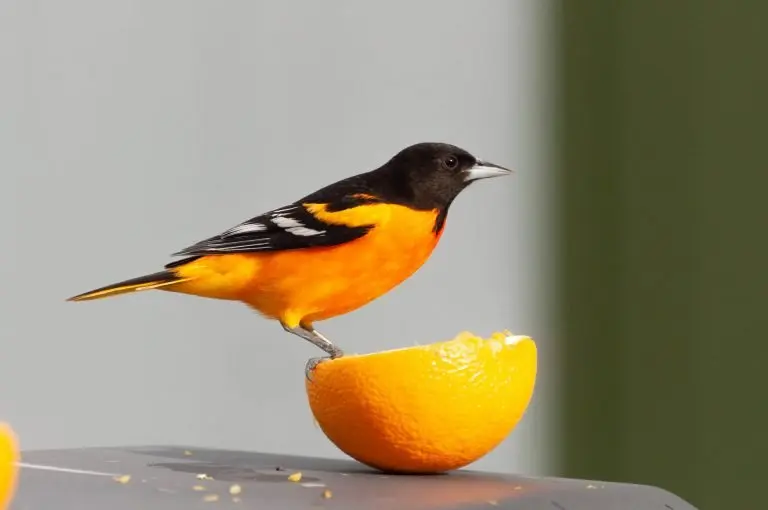
Baltimore Orioles are a colorful sign of spring in the east of North America. The adult males are bright orange and black with white wing bars on the black wings. The male birds have orange chests and bellies, black heads and backs.
Females are yellowish underneath and on the head and grayish-brown on the wings, their backs or brownish-yellow. They are about the size of a Robin but more slender and are members of the blackbird family.
- Length: 6.7-7.5 in (17-19 cm)
- Weight: 1.1-1.4 oz (30-40 g)
- Wingspan: 9.1-11.8 in (23-30 cm)
Breeding in Eastern and Central States, including central-southern Canadian provinces and along the southern border with the US, from April.
Baltimore Orioles, then migrate to Florida, Central America, and the Caribbean for winter, leaving as early as July.
They make incredible hanging bag-like nests woven from fibers.
Baltimore Orioles can be found high up in open woodland, riverbanks, and forest edges foraging for insects and fruit and they often come to parks and backyards.
Their diet is insects such as beetles, crickets, and grasshoppers as well as spiders and snails and they help eat pest species. They eat a wide variety of fruits and can damage crops such as raspberries, mulberries, cherries, bananas, and oranges.
To attract more Baltimore Orioles to your yard try oranges cut in half on a platform feeder or hanging from trees. Also, oriole feeders filled with sugar water. Plant fruit and nectar plants such as raspberries, crab apples, and trumpet vines.
2. Bullock’s Oriole
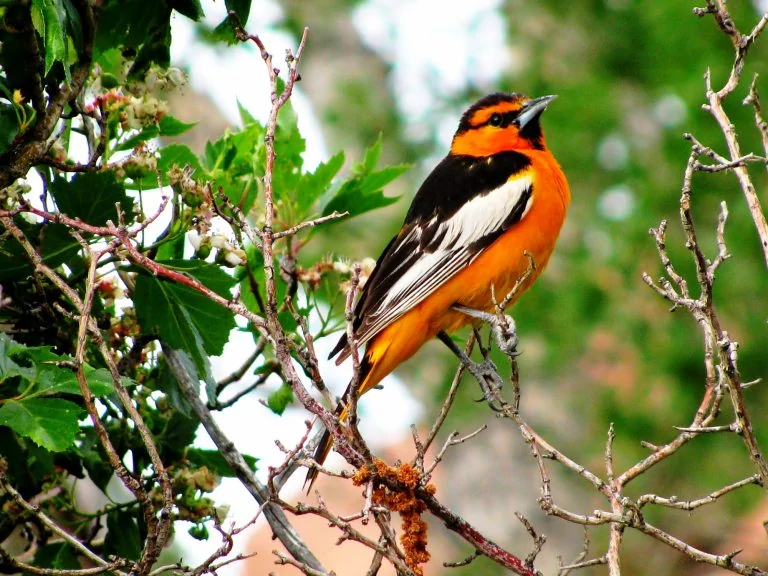
Bullock’s Orioles males have bright orange chests and bellies and black and white wings and black and orange markings on their heads.
Females and immature are duller in comparison with gray backs and yellow heads, tails and chests.
- Length: 6.7-7.5 in (17-19 cm)
- Weight: 1.0-1.5 oz (29-43 g)
- Wingspan: 12.2 in (31 cm)
Bullock’s Orioles breed in the western half of the US and spend the winter in Mexico. Their nests are woven from hair, grass and wool into a gourd shape and take up to 15 days to complete.
They can be found in open woodlands and parks and will visit backyards for fruit and grape jelly and nectar feeders.
3. Hooded Oriole
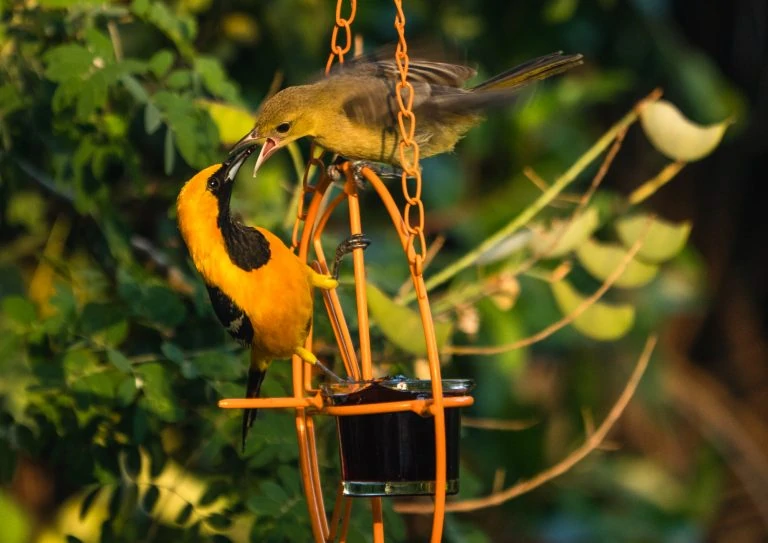
Male Hooded Orioles range from bright yellow to bright orange from their crowns down the chests and belly, and with black throats and backs.
Females and immatures are more yellow with grayish wings. Females also lack black face markings.
- Length: 7.1-7.9 in (18-20 cm)
- Weight: 0.8 oz (24 g)
- Wingspan: 9.1-11.0 in (23-28 cm)
Hooded Oriole males in Texas tend to be orange in color but those further west are yellow.
They breed in the southern US states, making hanging nests on the undersides of palm fronds. They winter in Mexico and some remain all year on the Gulf Coast of Mexico and Central America.
Some Hooded Orioles have stopped migrating from southern US states because of the ready supply of food from nectar feeders.
They live in dry open areas, especially near palm trees. Their nests are high at around 20 feet off the ground and are a hanging basket weaved from grass and plant material.
They will come to nectar feeders or use fruit to attract orioles.
4. Orchard Oriole
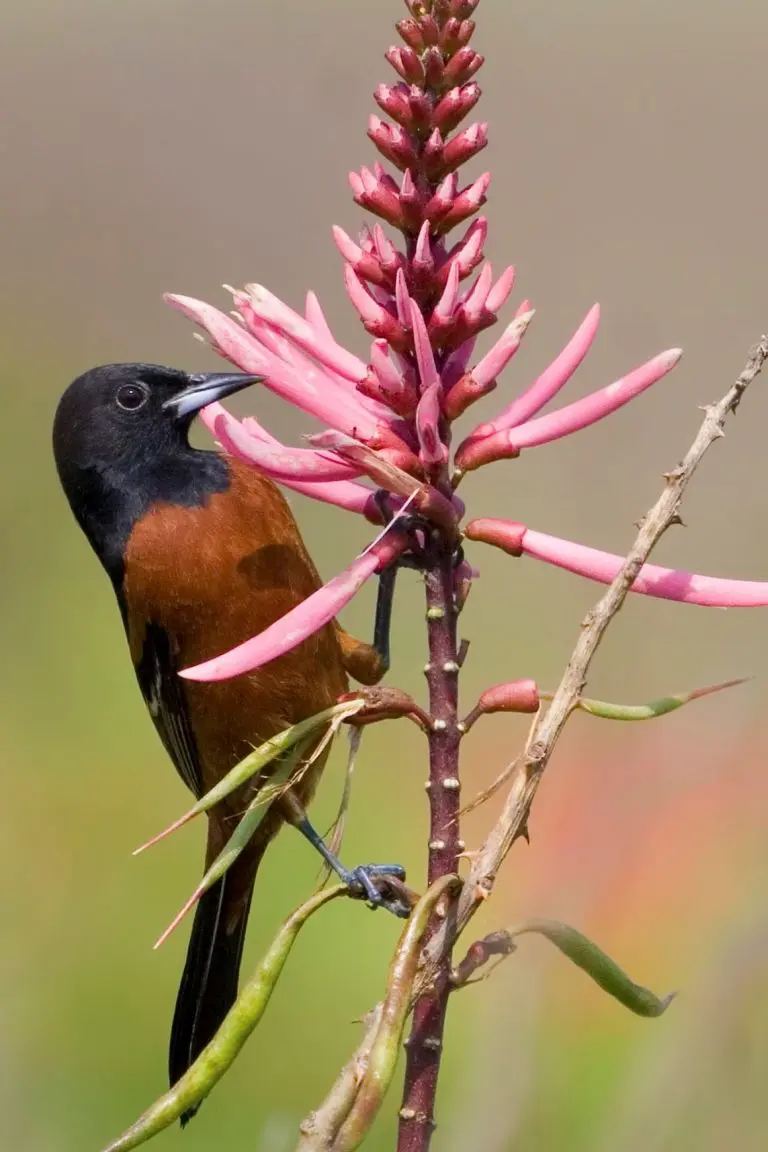
Orchard Orioles males have black heads and backs and reddish-orange chests and bellies. Females are greenish-yellow overall, paler underneath and darker on the back, with darker wings and white wingbars.
- Length: 5.9-7.1 in (15-18 cm)
- Weight: 0.6-1.0 oz (16-28 g)
- Wingspan: 9.8 in (25 cm)
Orchard Orioles breed in central and eastern states in summer, before migrating south to Mexico and Central America.
Preferring open woodland, Orchard Orioles can also be found along river banks and open shrubland and farms as well as backyards. They build hanging pouch-like nests.
Their diet is mostly insects such as ants, caterpillars, beetles, and grasshoppers, as well as spiders. they will also drink nectar from flowers and eat fruit such as mulberries and chokeberries.
To attract Orchard Orioles to your yard try nectar feeders or platform feeders with cut oranges or mango. Also, plant native berry plants such as mulberries or chokeberries.
5. Altamira Oriole
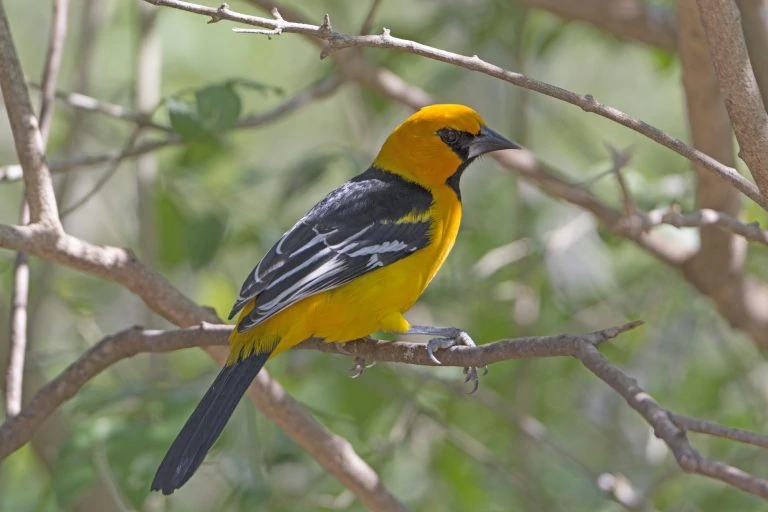
Altamira Orioles are bright yellowish-orange on their heads, chests and bellies and with black backs, wings and tails. These birds with orange heads also have black around the eyes and down the throat. Juveniles are more yellow and have olive backs rather than black.
- Length: 8.3-9.8 in (21-25 cm)
- Weight: 1.7-2.3 oz (47-64 g)
- Wingspan: 14.2 in (36 cm)
Altamira Orioles are rare in the US except in the Rio Grande Valley, Texas and they remain year-round.
Look for them in backyards at sunflower or nectar feeders or in wildlife refuges in southeastern Texas and along the Gulf Coast of Central America. They prefer open woodlands.
Altamira Orioles stay in pairs year-round. Try to look for their amazing hanging nests that measure up to 2 feet long.
6. Spot-breasted Oriole
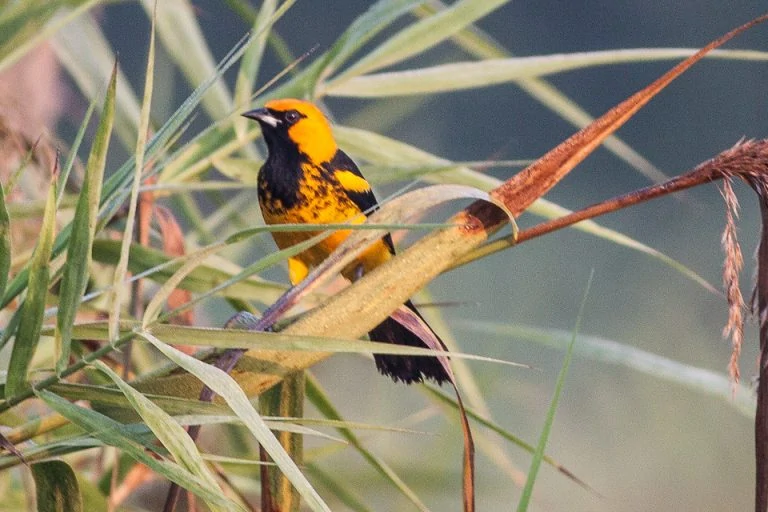
Spot-breasted Orioles are black and orange with black spotting on their orange breast and white on the wing edges. They have black around the face and chest and are black on the back, wings and tail. Juveniles are more yellow in color with dark backs, wings and tails.
- Length: 8.3-9.4 in (21-24 cm)
- Weight: 1.8 oz (50 g)
Spot-breasted Orioles can be found in Florida and along the Gulf Coast but they are not very common in the US. They mostly live in Mexico and Central America along the Pacific Coast.
They live in open woodlands and will visit backyards for fruit and nectar.
7. Streak-backed Oriole
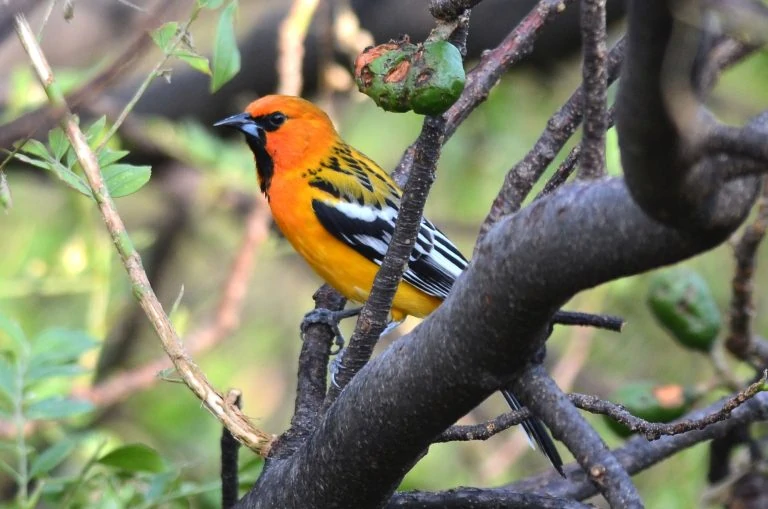
Streak-backed Orioles are orange and black orioles with orange chests, heads and bellies and black-streaked wings and a black tail. They have black around the eyes and chin.
They are rare in the US but can be seen in the southwest. Mexico and Central America is their main habitat.
They are found in tropical woodland, grassland and backyards.
8. American Redstart
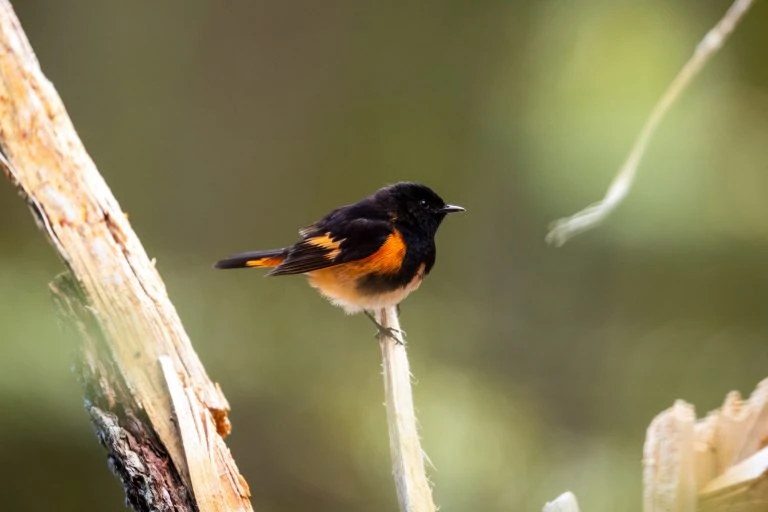
American Redstarts are mostly black with bright orange patches and a white belly. Females are olive-gray instead of black and have yellow patches.
- Length: 4.3-5.1 in (11-13 cm)
- Weight: 0.2-0.3 oz (6-9 g)
- Wingspan: 6.3-7.5 in (16-19 cm)
They have a vast breeding range across eastern US states and Canada and across to northwestern US states and Canada. They may also be seen during migration in central states.
They can be found in deciduous woodlands eating insects and also in backyards and thickets eating berries such as serviceberry and magnolia.
9. American Robin
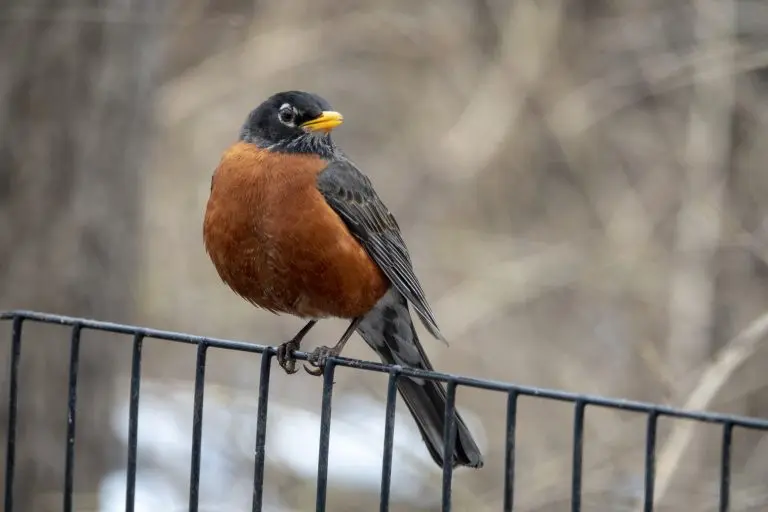
American Robins are a common sight on lawns eating earthworms. They have black heads and back with red or orange breasts. They tend to roost in trees in winter so you are more likely to see them in your backyard from spring.
- Length: 7.9-11.0 in (20-28 cm)
- Weight: 2.7-3.0 oz (77-85 g)
- Wingspan: 12.2-15.8 in (31-40 cm)
American Robins can be spotted in all US states and Canada. Only those in Canada and Alaska migrate south for the winter.
American Robins can be found in many habitats, from woodlands, forests, and mountains to fields, parks, and lawns. They eat earthworms, insects, snails, and fruit.
You can attract more American Robins to your yard with sunflower seeds, suet and peanut hearts, fruit, and mealworms. Platform feeders are best or food scattered on the ground. Also try planting some native plants that produce berries such as juniper, sumac, hawthorn, and dogwood.
10. Red-breasted Nuthatch
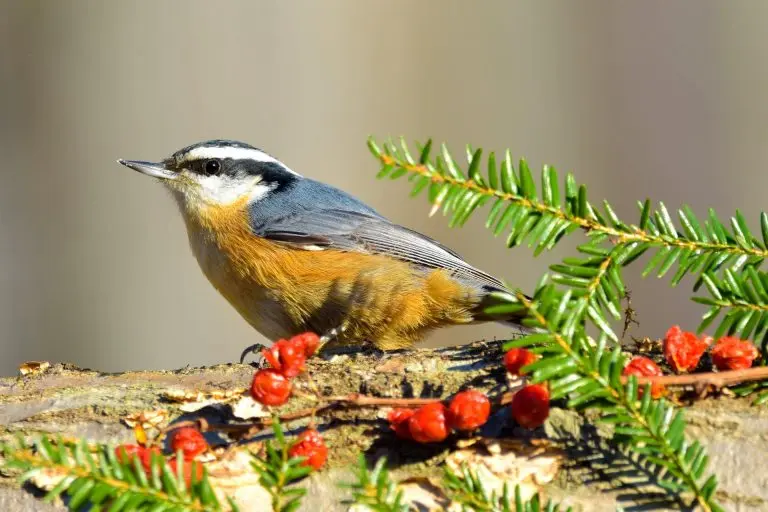
Red-breasted Nuthatches remain all year in northeastern and western states, Alaska and Canada but may move south across all of North America in winter if cone crops are poor.
Red-breasted Nuthatches are small birds that are blue-gray birds with black and white stripes on the head and orange-red chests and bellies and down the sides.
- Length: 4.3 in (11 cm)
- Weight: 0.3-0.5 oz (8-13 g)
- Wingspan: 7.1-7.9 in (18-20 cm)
Red-breasted Nuthatches can be found in coniferous woods foraging for cones and they do visit backyard feeders.
You can attract more Red-breasted Nuthatches to your backyard with black oil sunflower seeds, suet feeders, peanuts, and mealworms.
11. Blackburnian Warbler
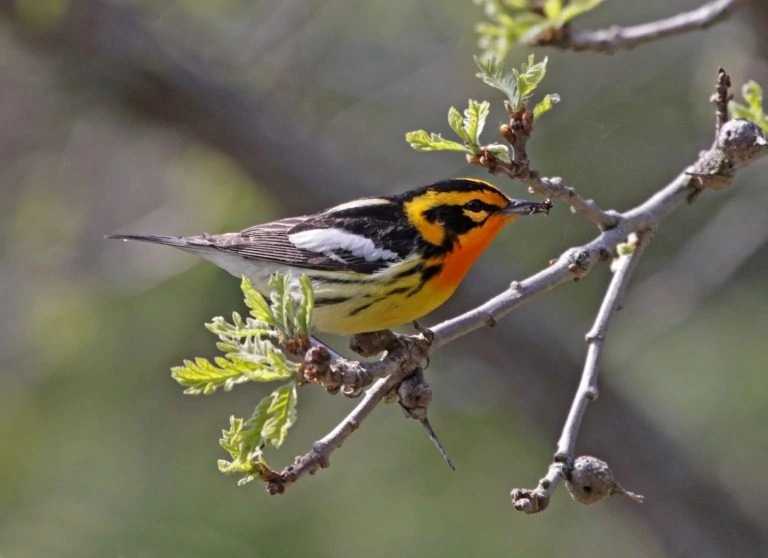
Blackburnian Warbler males are birds with orange chests, throats and face marking, black backs and wings and white with black streaks on the belly. Females are yellower. They have distinctive dark triangles on each side of their face, by their eyes.
- Length: 4.3-4.7 in (11-12 cm)
- Weight: 0.3-0.4 oz (8.9-12.6 g)
- Wingspan: 7.9-9.1 in (20-23 cm)
Blackburnian Warblers can be seen during migration in eastern US states. They breed in Canada and northeastern US states and some may breed as far south as Virginia or North Carolina. They spend winters in South America.
They can be found in woods and forests hunting for caterpillars, but they are difficult to spot as they are often up at the top of trees hidden from view by leaves.
12. Brambling
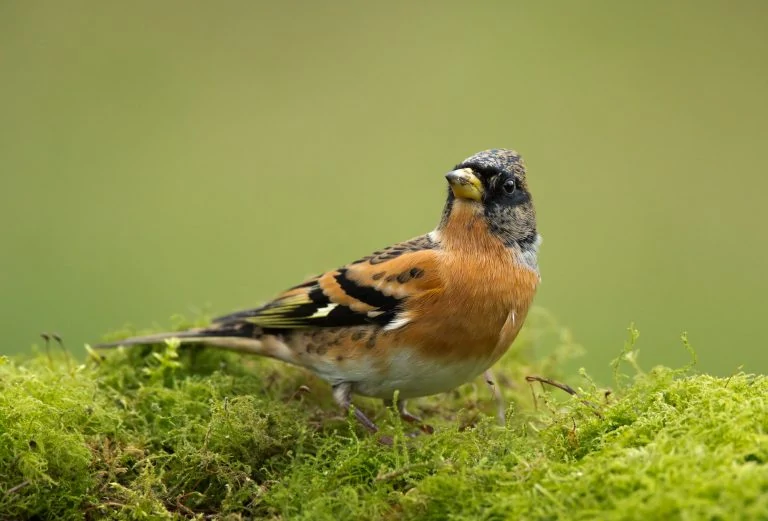
Bramblings are orange-breasted birds with, white bellies, black heads and dark backs. Females are paler than males.
- Length: 16 cm
- Weight: 23-29 g
- Wingspan: 25–26 cm
Bramblings are finches that are usually spotted in Europe and Asia but some appear in Alaska during migration. Those birds that appear in the US may stay in the US and move south during the winter, so they can be spotted in many US states. They may also visit backyard feeders.
13. Black-headed Grosbeak
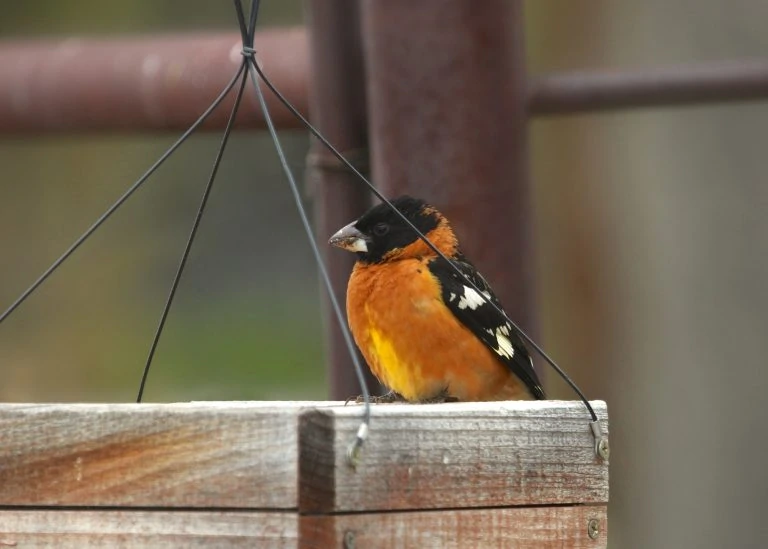
Black-headed Grosbeaks are large songbirds with orange breasts and throats and black wings and heads. Females are brown on the back and with brown spots on their pale orange breasts.
- Length: 7.1-7.5 in (18-19 cm)
- Weight: 1.2-1.7 oz (35-49 g)
- Wingspan: 12.6 in (32 cm)
Black-headed Grosbeaks breed in western US states and migrate to Mexico for the winter. They can be found in many habitats with access to water and often visit backyards.
Attract Black-headed Grosbeaks to your backyard with sunflower seed feeders. They will also feed on oriole feeders.
14. Western Bluebird
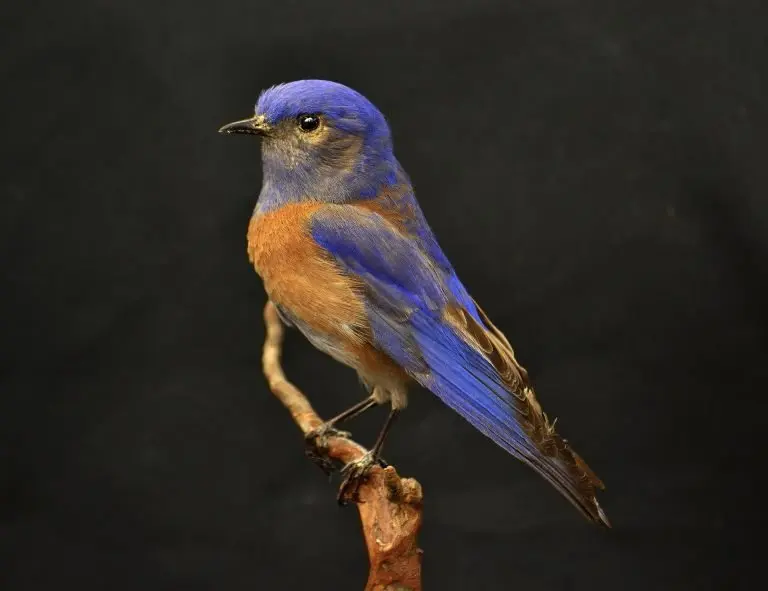
Western Bluebirds blue birds with orange chests. They are very social small stocky thrushes that are shiny blue on the back and rust-orange on the breast and across the upper back in the males. Females are not so bright, instead, they are a dull buff-gray, with pale orange on the breast and blue tints to the wings and tail.
Western Bluebirds are found in western states and do not usually migrate. However, some birds in the far northwest may migrate south or to lower elevations. They tend to live in woodlands rather than open areas and are readily found in areas that have dead trees such as burned forests and logged areas.
The diet of Western Bluebirds is mostly insects in summer and fruit and seeds in winter. Caterpillars, beetles, and ants, as well as spiders and snails or other ground-dwelling insects, are common summer food. Elderberry, grapes, mistletoe, raspberries, blackberries, sumac, juniper plus more make up their winter diet.
To attract more Western Bluebirds to your yard offer mealworms in summer and put up a nest box, also plant berry plants such as elderberry, raspberries, and juniper.
15. Eastern Bluebird

Eastern Bluebirds are blue and orange birds. They are small thrushes with big, rounded heads, large eyes, and big bellies.
The males are deep blue on the back and a reddish color underneath. Females are grayer above with some blue in the wings and tail and a less vivid orange-brown breast.
- Length: 6.3-8.3 in (16-21 cm)
- Weight: 1.0-1.1 oz (28-32 g)
- Wingspan: 9.8-12.6 in (25-32 cm)
They live all year over most of their range in the Eastern States but may migrate south for winter from the far north.
They live in meadows and can be spotted perched on wires and posts or low branches looking for insects.
You can attract more Eastern Bluebirds to your backyard by offering mealworms and nest boxes if your yard is fairly open and spacious.
16. Northern Red Bishop
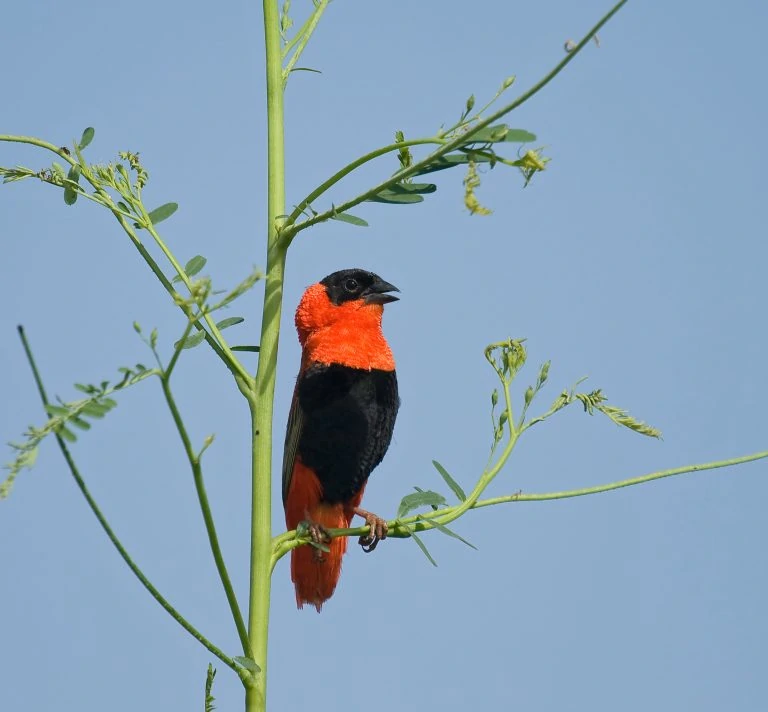
Northern Red Bishops are small weaver birds originally from Africa. Male birds have orange chests and back of the head and black bellies and back in the breeding season, some tend to be more red and black. Females are brown and white, but with a similar pattern.
Northern Red Bishops are about 4 inches long and usually live in the tall grasslands of northern Africa. Populations thought to be from escaped pet birds now live in California and Texas and Florida.
Their diet is seeds and insects and the males build a spherical nest with an entrance on the side.
17. Western Tanager
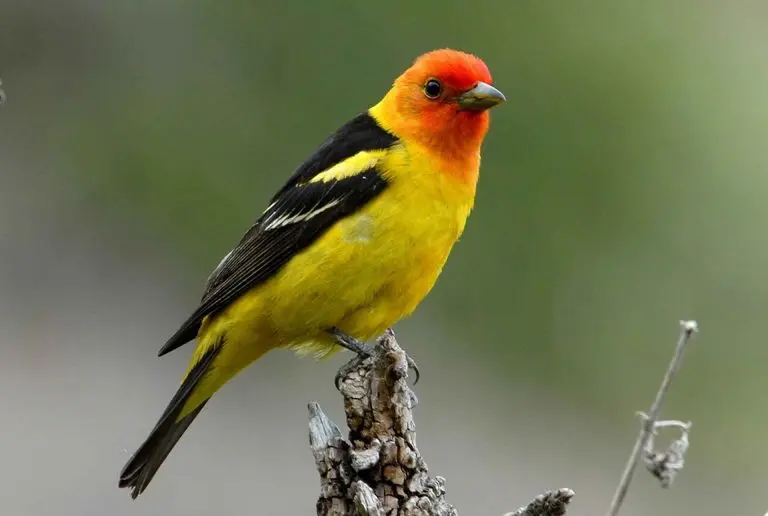
Western Tanagers have flaming orange-red heads, throats and onto their chests. They have yellow bodies and black wings. They can be found all over western states breeding towards the north and then migrating south for winter.
They live in open conifer forests but stay hidden in the canopy, despite their bright coloring. The red coloring probably comes from eating insects that produce a pigment that the Western Tanagers cannot produce themselves.
You can attract Western Tanagers with dried fruit, cut oranges, and other fruits from bird feeders.
18. Scarlet Tanager
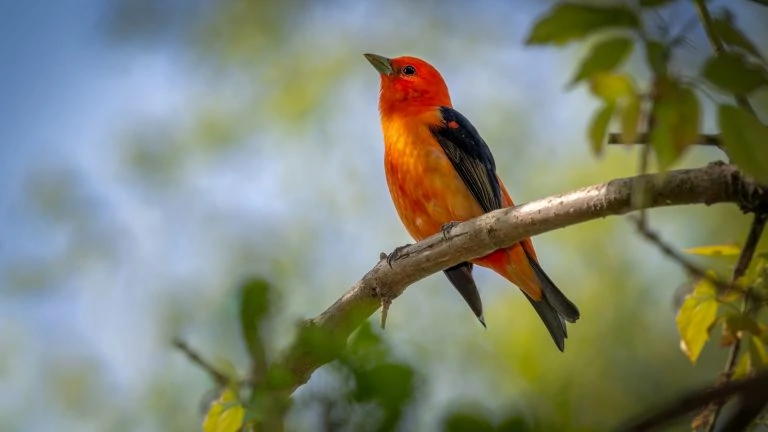
Scarlet Tanagers are birds with orange-red bodies and red heads, that is very bright, and with black wings and tail. They breed in eastern forests in summer before migrating to South America.
Scarlet Tanagers can be hard to spot as they stay high in the forest canopy.
You can attract more Scarlet Tanagers by planting berry plants such as blackberries, raspberries, huckleberries, juneberries, serviceberries, mulberries, strawberries and chokeberries.
19. Flame-colored Tanager
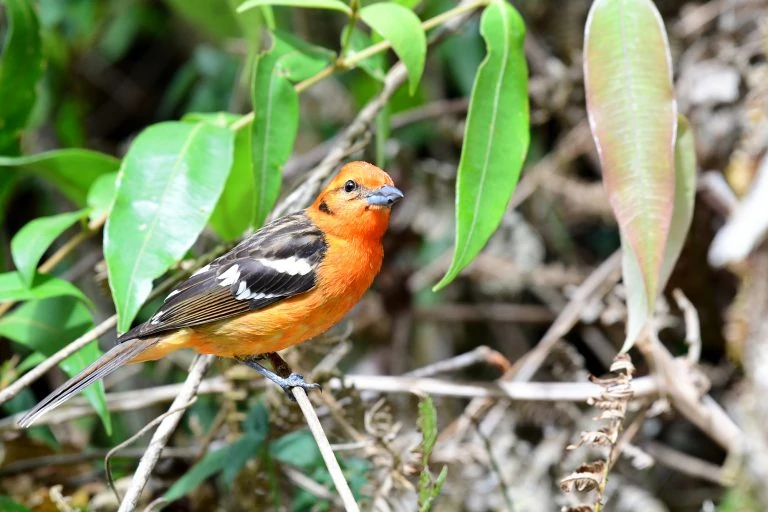
Male Flame-colored Tanagers are brightly colored birds with orange-red coloring, with darker wings and tails. Females are more yellow-orange. They have orange-red heads, chests and bellies and dark wings with white markings.
Length: 7 – 7.5 inches long (18 – 19 cm) Weight 1.13 – 1.71 oz (32 – 48 g)
A rare visitor to the US, the Flame-colored Tanager has started breeding in Arizona and has been spotted in Texas. They usually inhabit woodland Mexico and Central America. Their diet is insects and berries.
20. Northern Cardinal
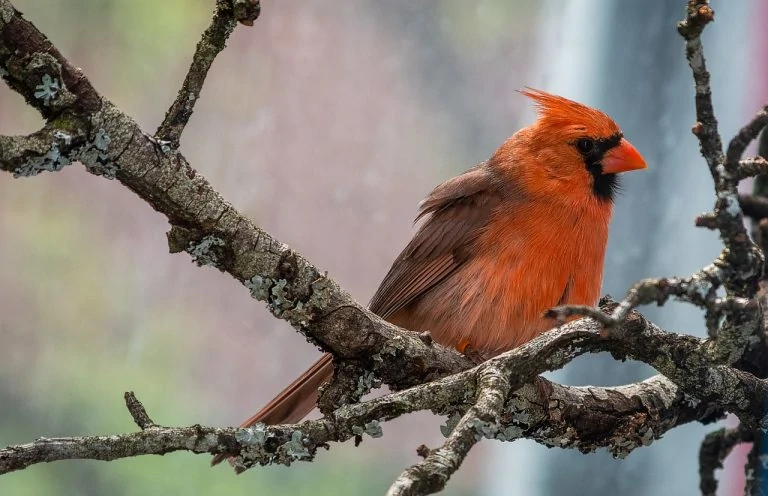
Northern Cardinals are usually red in color, with black around their faces. However, Northern Cardinals can look orange in color, which is thought to be due to nutrient availability.
The females are also a little showy with their brown coloring, sharp brown crest, red highlights, and red beaks.
Northern Cardinals are found in eastern and southern states. They will sometimes attack their own reflection during breeding season as they obsessively defend their territories.
You can attract more Northern Cardinals to backyard feeders with sunflower seeds, peanut hearts, millet, and milo.
They will feed on large tube feeders, hoppers, platform feeders, or food scattered on the ground.
21. Rufous Hummingbird
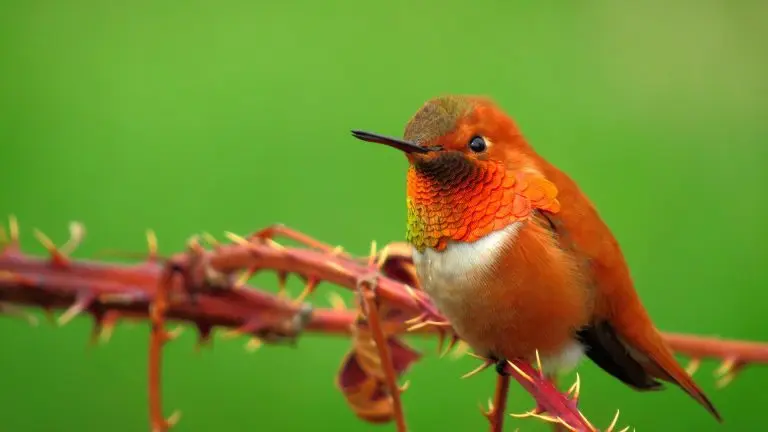
Rufous Hummingbirds are bright orange hummingbirds with a white patch below the throat, and an iridescent red throat in the males. The females are greenish-brown on the back and rusty colored on the sides with a whitish belly. Their numbers are in decline by around 60% since the 1970s
- Length: 2.8-3.5 in (7-9 cm)
- Weight: 0.1-0.2 oz (2-5 g)
- Wingspan: 4.3 in (11 cm)
Rufous Hummingbirds are one of the longest migrating birds relative to their size, traveling up to 4000 miles each way. They breed in northwest Alaska and northwest Canada in the summer and migrate down to Mexico and the Gulf Coast for winter.
Migration of Rufous Hummingbirds is north along the Pacific Coast in spring and by the Rocky Mountains in late summer and fall. Migration in the spring of Rufous Hummingbirds starts in February and they usually reach Alaska by mid-April. Migration in the fall is in July and August and ends by October.
A study has shown that Rufous Hummingbirds are starting their migration earlier and traveling north more inland than before.
Rufous Hummingbirds feed mostly on nectar from colorful tubular flowers and from insects such as gnats, midges, and flies. They will also visit hummingbird feeders.
They build a nest high up in trees using soft plant down and spider webs to hold it together. They lay 2-3 tiny white eggs that are about 0.5 in (1.3 cm) long. Their habitat is mountain meadows and coniferous forests.
They are very aggressive and chase off any other hummingbirds that may appear, even larger hummingbirds or resident ones during migration. During migration, they won’t hang around long but will still chase off most other hummingbirds given a chance.
22. Allen’s Hummingbird
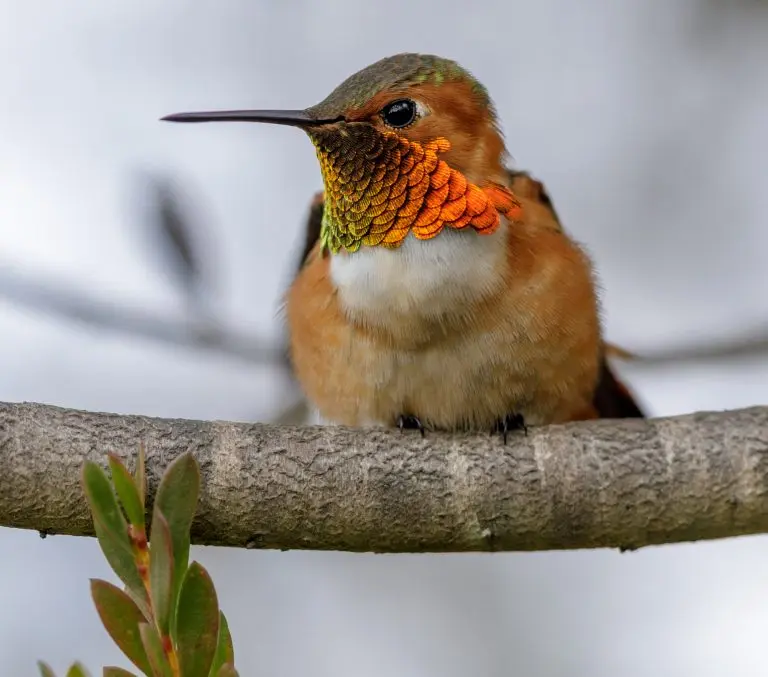
Allen’s Hummingbirds look very similar to Rufous Hummingbirds so it’s hard to tell them apart in the narrow band of coastal forest and scrub they inhabit between California and Oregon.
Male Allen’s Hummingbirds are generally orange hummingbirds and both males and females have long straight bills and coppery-green backs but the females lack the bright throat coloring.
- Length: 3.5 in (9 cm)
- Weight: 0.1-0.1 oz (2-4 g)
- Wingspan: 4.3 in (11 cm)
The difference between Allen’s and Rufous Hummingbirds is the narrow outer tail feathers in Allen’s Hummingbird. They build nests at no fixed height near shady streams and have up to 3 broods a year.
Allen’s Hummingbirds spend winter in Mexico and migrate as early as January up to the Pacific Coast in California and Oregon but they are most common between March and July. Some remain residents in central Mexico and around Los Angeles.
23. Varied Thrush
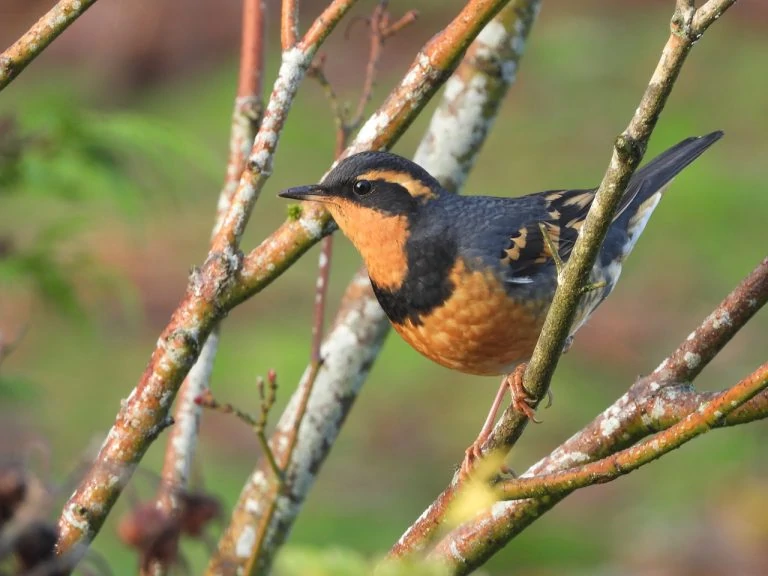
Varied Thrush males are birds with orange breasts and throats and black backs and with a black ‘necklace’ around the throat. The males also have orange bars on the wings and orange stripes on the sides of their black heads. Females are paler and have more brown tones on the back.
- Length: 7.5-10.2 in (19-26 cm)
- Weight: 2.3-3.5 oz (65-100 g)
- Wingspan: 13.4-15.0 in (34-38 cm)
Varied Thrush can be found along the Pacific Coast and Breed in Alaska and Northwestern Canada. Some remain all year in British Columbia and Northwestern Us states, along the coast. In winter birds from Alaska and inland Canada move south as far as California.
They are shy birds that hide in the forest looking for insects in the summer and berries and seeds in the winter.
24. Western Spindalis
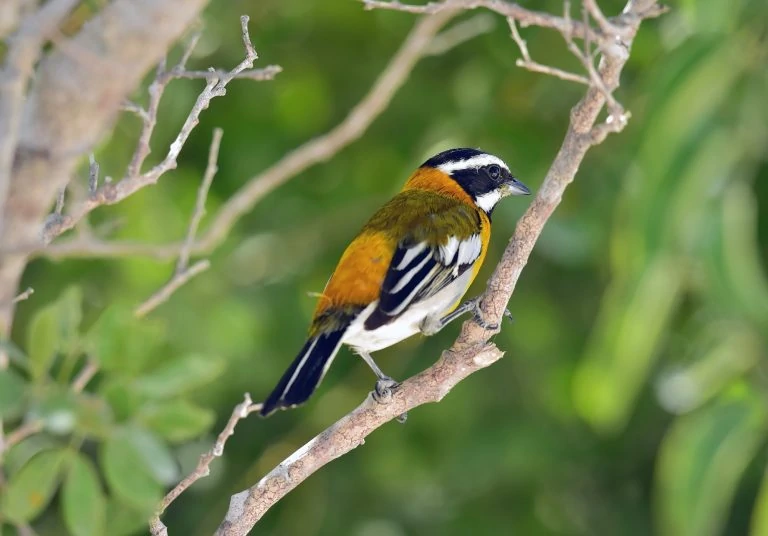
Western Spindalis males have bright orange chests and black-and-white striped heads. Their backs are either green or black with some orange color. Females are less bright but have similar coloring and patterns.
They live predominantly in the Caribbean but they also are found in southern Florida. Western Spindalis Habitat is are subtropical and tropical forests.
Western Spindalis are songbirds that feed on fruit, berries, seeds and insects. They make a small cup-shaped nest made from grass and weeds.
25. Stonechat
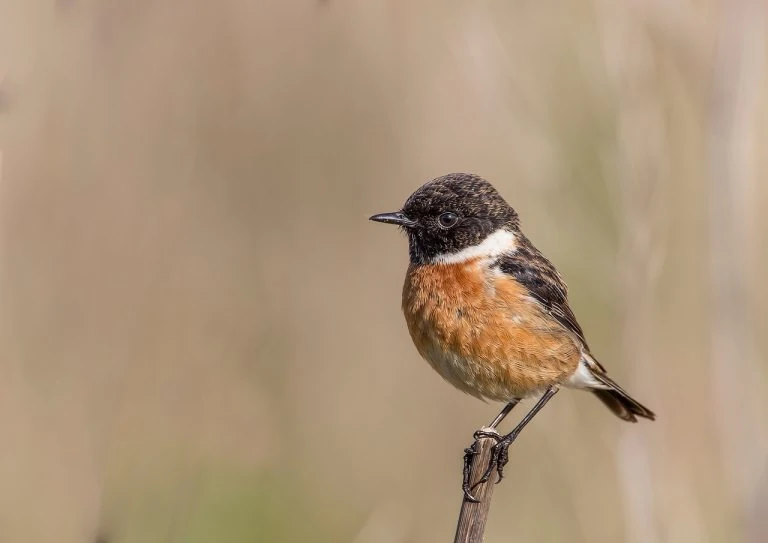
Stonechats are only vagrants to the US and are originally from Europe and western Russia. They are small thrushes with orange breasts, black heads and back and with a white collar around the neck.
Female Stonechats are similar but duller. It has been spotted in northwestern US states, but rarely.
I really hope you have enjoyed finding out all about birds with orange chests and this guide has helped you to identify birds that you have spotted.

